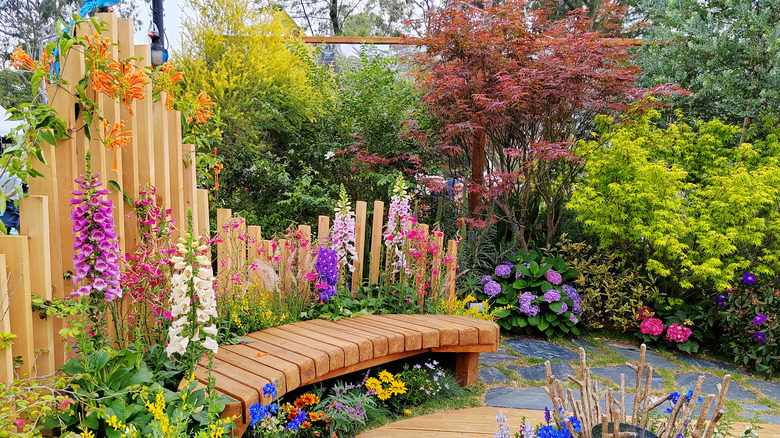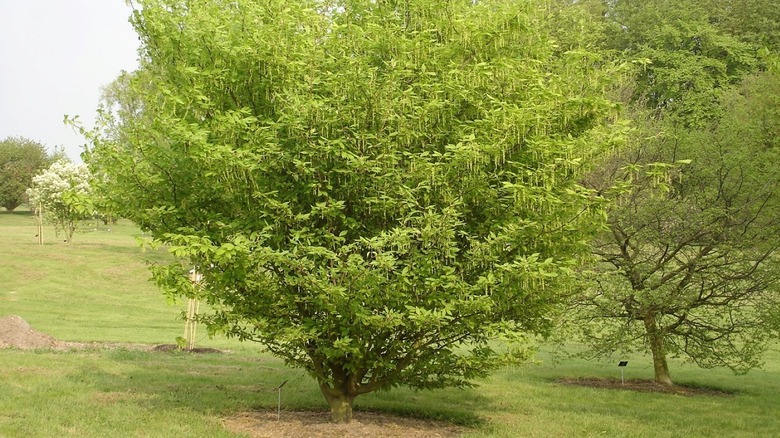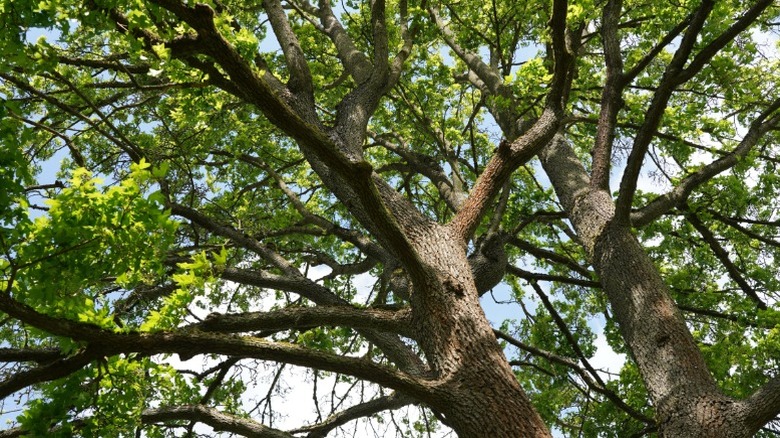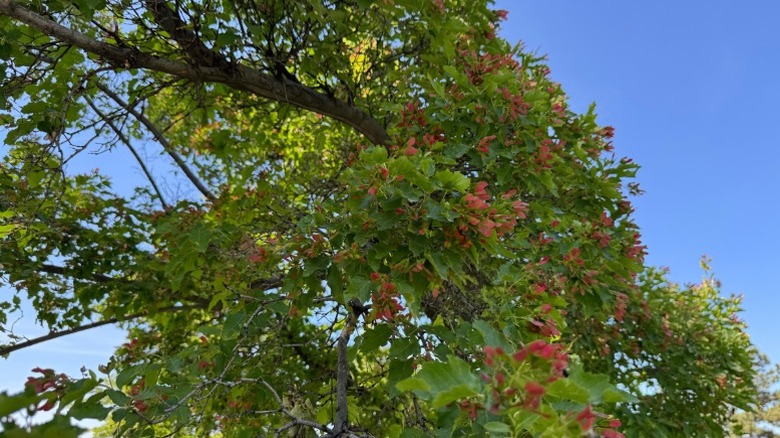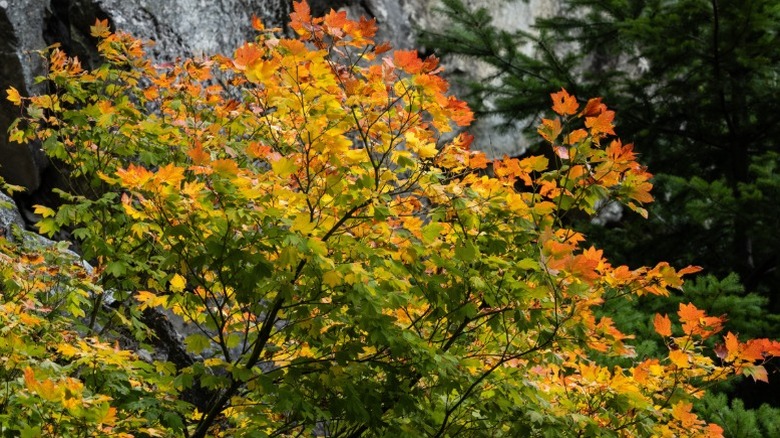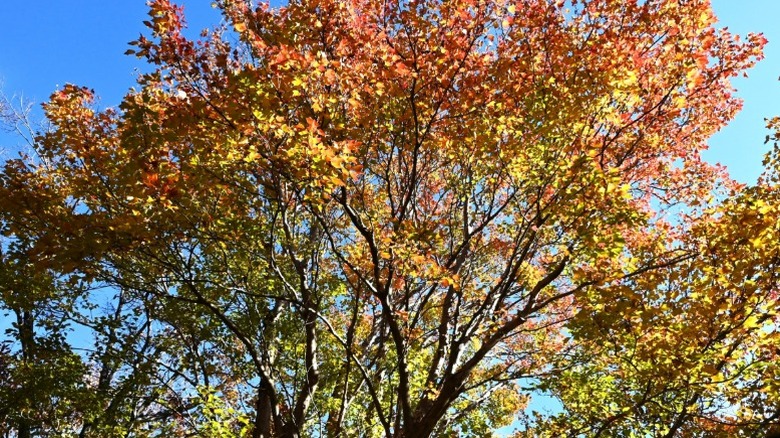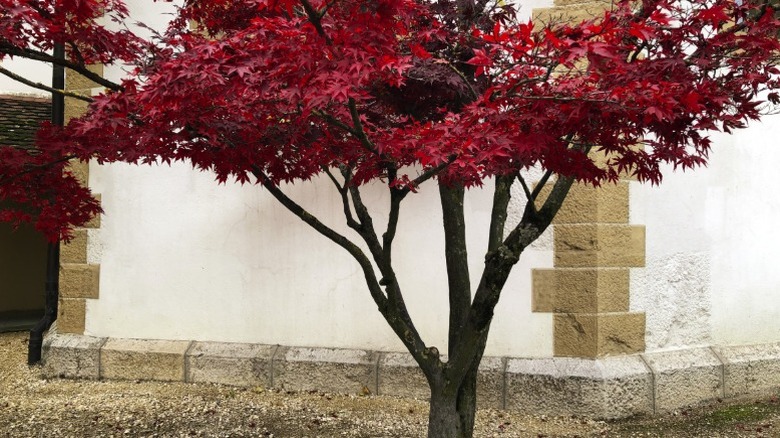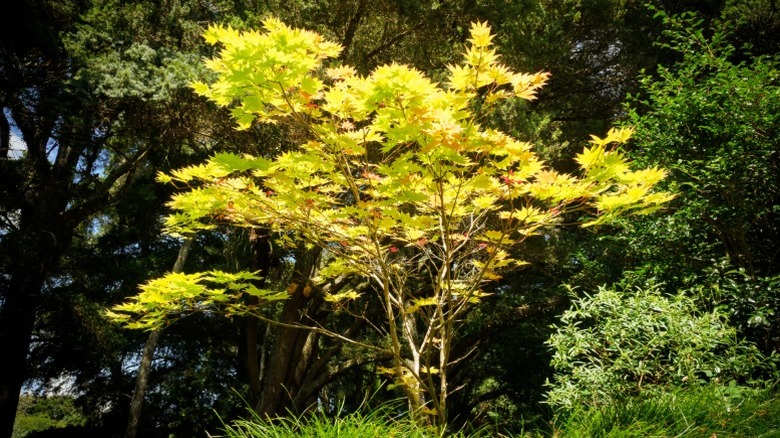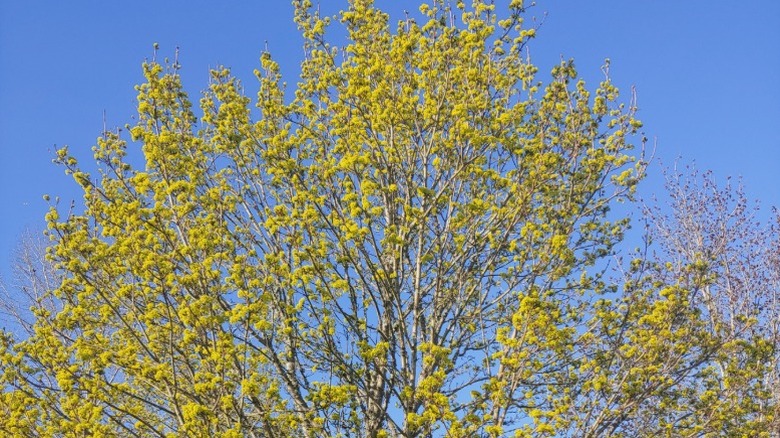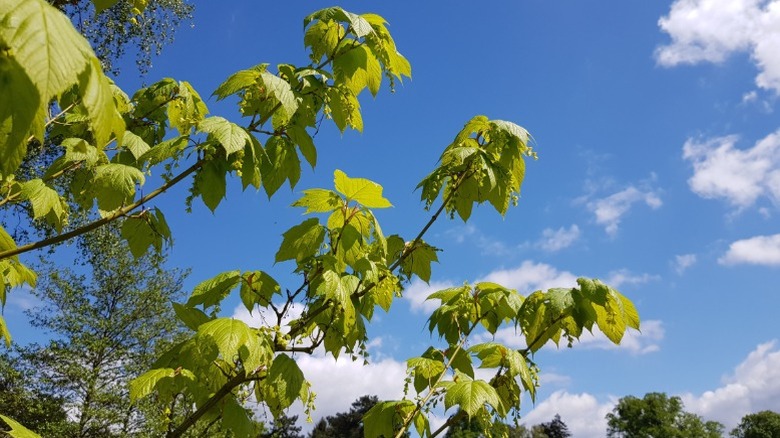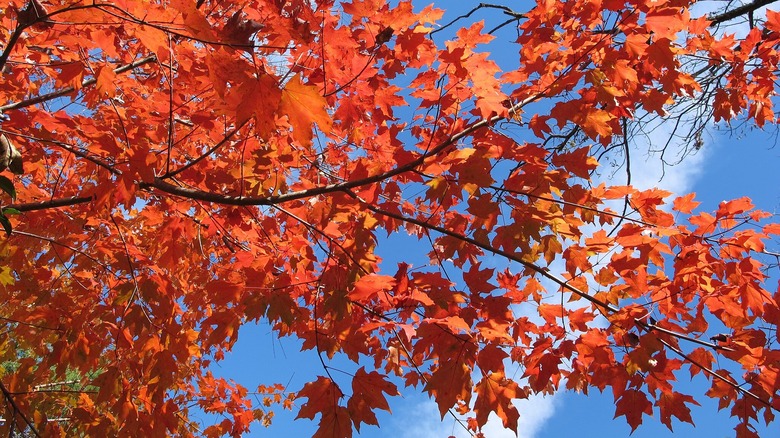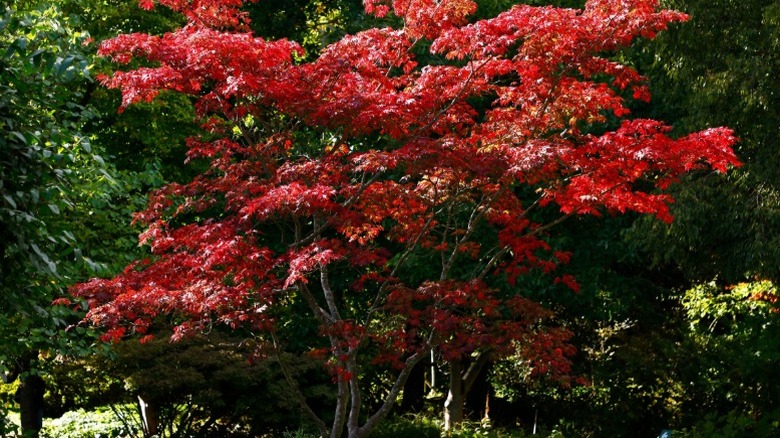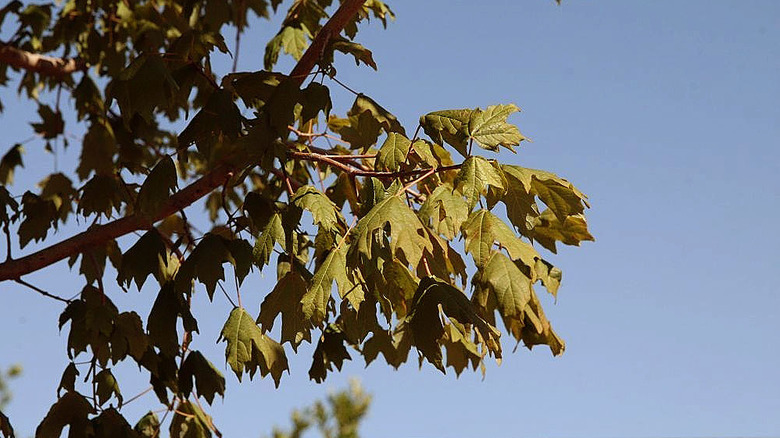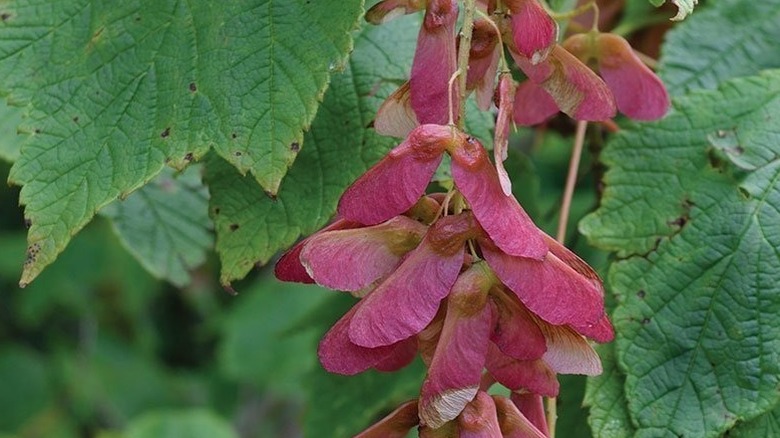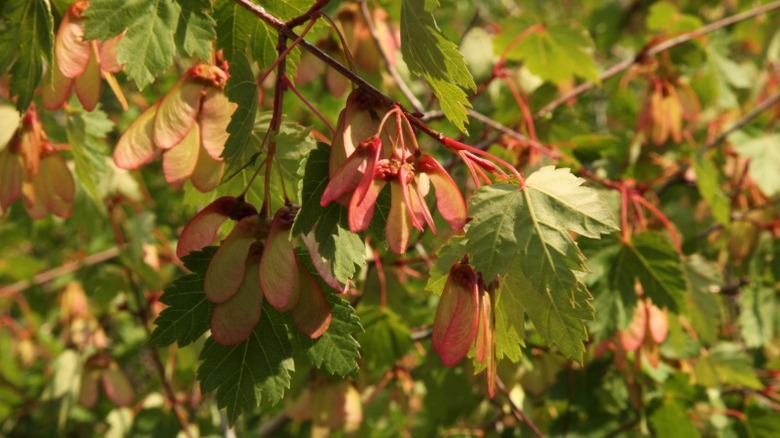16 Unique Maple Varieties Perfect For Small Yards
Around the world, maple trees are a popular choice for shade and color. All maples are Acer species, belonging to a group of deciduous trees that is actually fairly diverse, ranging from the tall bigleaf maple trees to the small Japanese maple trees. This great diversity works in the favor of homeowners, because there are maple species and cultivars that work in all types of landscapes. If you have a small yard and think that a large sugar maple tree will overtake the space, don't give up hope. There are many unique maple varieties that grow well in small yards, not reaching more than 30 to 35 feet at their tallest.
If you want stunning maple trees to add drama to your yard but want to avoid having them crowd your space, consider small to medium varieties like trident maple, paperbark maple, and Japanese maple. These are all small trees that won't overtake your yard but will still provide the appealing maple characteristics that you know and love.
Hornbeam maple
Native to Japan, the hornbeam maple (Acer carpinifolium) features smooth, dark gray bark and a densely branching form. It is a unique type of maple tree because its leaves resemble another species of tree, Carpinus, from which it gets its name. This type of maple is one of the smallest options available, growing only to 20 to 25 feet tall. A good choice for small areas, this maple's leaves turn a pretty bronze or gold color in fall. This species is hardy in zones 4 through 8 in the U.S.
Hedge maple
Native to Europe and western Asia, the hedge maple (Acer campestre) is receptive to repeated, severe pruning, making it ideal if you need to keep it confined to a small space. Unlike some trees, which can be damaged by trimming, the hedge maple requires it to maintain its shape. Hedge maples are also known as field maples because they are commonly found growing in open areas. Depending on the cultivar, this maple grows between 25 and 35 feet tall and is hardy from zones 5 through 8. Prune this tree into a privacy screen, a good choice for a small yard.
Tatarian maple
This is a small, useful tree for compact yards. Native to western Asia and southeastern Europe, the Tatarian maple (Acer tataricum) grows only between 15 and 30 feet tall. It thrives in a variety of soils without issue, but prefers well-drained soil. Hardy from zones 3 to 8, this maple species might be considered weedy, but it can be controlled in smaller, less open locations. This maple tree is also a tree you can plant without worrying about damaging water lines. Be warned that the tree is considered invasive in some areas of the U.S., so be sure to check before planting.
Vine leaf maple
This maple species is native to western North America, particularly moist woodlands and streambanks. Known as the vine leaf maple (Acer circinatum), or sometimes just vine maple, this species is very popular in the Pacific Northwest. Plant in full sun to achieve upright growth or shade for a more horizontal, shrublike look. A good tree for a small yard, it has a spreading and sprawling habit and grows only 10 to 25 feet. Hardy from zones 4 through 7, the vine leaf maple should not be heavily pruned to avoid ruining its distinct look.
Trident maple
A small, pretty tree, trident maple (Acer buergerianum), is native to eastern China, Japan, and Korea. Its name comes from the shape of its leaves, which feature three straight-facing, triangular lobes. When left unpruned, trident maples will develop multiple stems and low branches. To train a single trunk, cut back competing stems every three years for the first 20 years of growth. This maple species reaches 25 to 35 feet tall and is hardy in zones 5 through 9.
Japanese maple
One of the most popular and compact maple trees in the U.S. is not native to North America. The Japanese maple (Acer palmatum) originates in Korea and Japan and is now available in hundreds of cultivars. Growing at most between 12 and 25 feet high, they are hardy from zones 5 through 8. Japanese maples are prized for their stunning leaf colors, both in spring and fall. The best place to plant a Japanese maple depends on the cultivar, but most prefer partial shade. Try 'Bloodgood' for deep red leaves that turn bright crimson in autumn.
Korean maple
A small, pretty ornamental maple, the Korean maple (Acer pseudosieboldianum) grows well in either full sun or partial shade areas. It reaches 15 to 25 feet tall and is a good shade tree for small yards. Korean maples resemble Japanese maples, but can be grown in colder areas that cannot reliably grow Japanese maples. It's hardy in zones 4 through 8. A unique characteristic of this species is the way its leaves turn purple, yellow, orange, green, and red in autumn, all on the same tree, and sometimes with different pigments on the same leaf.
Rocky Mountain maple
A small tree for limited spaces, the Rocky Mountain maple (Acer glabrum) is a unique tree with an often shrubby habit. This maple is adaptable, making it a great option for landscaping anywhere in your yard. It commonly showcases multiple stems, appearing almost like short, 5-foot-tall shrubs. These trees reach 30 feet tall at their highest but may have bushy, dense growth. They are hardy from zones 3 through 8 and have a wide range in mountainous regions of North America, from New Mexico all the way to Idaho and into Canada.
Striped maple
A fantastic, North American native maple is the striped maple (Acer pensylvanicum), which features beautiful striped bark. Other common names draw on its appearance, with goosefoot maple referencing its uniquely shaped leaves. This maple tree thrives in cool, moist soils, so avoid planting it where it will get excessive heat or sun. It's great for small yards as it only grows between 15 and 30 feet tall, but be careful growing near wooded areas, as this tree is a favorite of moose and deer (hence its other common name, moosewood!). This maple is hardy in zones 3 through 7.
Chalk maple
If you're seeking a maple that will thrive a little further south, check out the chalk maple (Acer leucoderme). This species is native to the southeastern U.S., including Texas and down to northwest Florida. It's hardy in zones 5 through 9. Called chalk maple due to its smooth, white bark, older trees develop blackish ridges at their base. A shorter maple, this tree grows between 25 and 30 feet, ideal for a smaller yard or near a deck. Use this species for contrast against a dark building to highlight its white bark and bright autumn foliage.
Paperbark maple
Distinguished from other maple species by its bronze-colored bark, which starts to peel early on in its growth, the paperbark maple (Acer griseum) is an excellent tree for a small space since it only reaches between 20 and 30 feet at maturity. This Asian species is a maple tree that can beautify your yard year-round, and it also transplants well. A very hardy type of maple, the paperbark can be grown in zones 4 through 8, tolerates clay soil, and is often one of the last to change colors with bright red and orange hues.
Full moon maple
Add a different texture to your yard with a full moon maple (Acer japonicum), which has similarities to the more popular Japanese maple. This species features big leaves reminiscent of the full moon, with soft hairs on their underside. Full moon maple trees are a short species like Japanese maples, growing 15 to 30 feet at maturity. Hardy from zones 5 through 7, their leaves are sensitive to hot summers in the southern U.S. Opt for the dwarf 'Aconitifolium' cultivar, which features crimson leaves in fall and grows well close to homes or patios.
Florida maple
Although sometimes considered a subspecies of the sugar maple, Florida maple (Acer floridanum) is now classified as its own distinct maple species. Naturally occurring mainly in the Florida panhandle, the Florida maple or southern sugar maple is capable of reaching up to 60 feet in height, but typically tops out at 20 to 30 feet, making it perfect for a small yard. It's hardy from zones 6 through 9 and grows throughout the Atlantic and Gulf coastal plains. Use as a shade tree in hurricane zones, as its smaller stature and strong branches will protect it from strong winds.
Mountain maple
Although it may be difficult to find at a nursery, the mountain maple (Acer spicatum) is a beautiful, short maple species native to the northern U.S. Particularly well-suited to mountainous regions, the mountain maple is a key species preventing erosion on steep slopes and streambanks in the Great Lakes region and into the Appalachian Mountains. This slow-growing tree typically reaches 10 to 25 feet tall, ideal for compact yards without a lot of room. Hardy from zones 2 through 7, this maple handles cold well and is a great native species to attract pollinators.
Bigtooth maple
This smaller species is native to the U.S. and is related to the sugar maple, but does not grow as tall. The bigtooth maple (Acer grandidentatum) typically averages 35 feet at its highest but also can grow as a shorter, multistemmed shrub. It is sometimes classified as a subspecies of the sugar maple and is hardy in zones 5 through 8. This tree has large, showy leaves with noticeable teeth. Great as an ornamental tree for a smaller landscaping space, plus it can be tapped for maple sugar.
Douglas maple
A subspecies of the Rocky Mountain maple, the Douglas maple (Acer glabrum var. douglasii) can be found growing in southeast Alaska and British Columbia, into Oregon, and as far east as Montana and Idaho. Similar in characteristics to the Rocky Mountain maple, this tree gets as tall as 30 feet but can also be grown as a shrubby plant. Its smaller stature and tolerance of a wide range of soil and climate conditions (including poor soil, drought, and strong winds) make it ideal for smaller spaces. The Douglas maple is hardy in zones 4 through 8.
